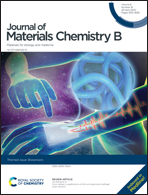Nucleoside-based fluorescent carbon dots for discrimination of metal ions†
Abstract
Carbon dots (Cdots) play an important role in many biological and chemical applications. To prepare strongly fluorescent Cdots, the starting material should contain nitrogen in addition to carbon. Nucleobases are nitrogen rich with interesting metal binding properties. In this work, we prepared a series of Cdots with citrate as the carbon source, and ethylenediamine, adenosine, cytidine, thymidine or guanosine as the respective nitrogen sources. The resulting Cdots were all fluorescent with the ethylenediamine sample being the most strongly emissive. These Cdots were then tested for their metal sensitivity and all tested metal ions can quench their fluorescence. The fluorescence of the G-Cdots prepared with guanosine was quenched most efficiently by Cu2+, while the Cdots prepared with ethylenediamine were more sensitive to Hg2+. With the differential quenching by different metal ions, we prepared a sensor array to discriminate multiple metal ions, and quantified Cu2+ and Hg2+ at the same time. Our work has expanded the range of starting materials for preparing Cdots and showed that by tuning the precursor composition, Cdots with different optical and metal binding properties can be obtained, which is useful in constructing a sensing platform for a large number of metal ions.

- This article is part of the themed collection: Biosensors


 Please wait while we load your content...
Please wait while we load your content...